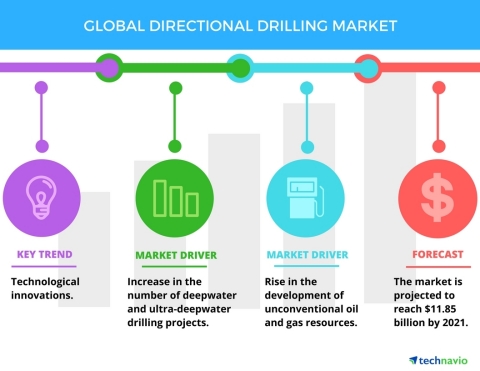LONDON--(BUSINESS WIRE)--Technavio’s latest market research report on the global directional drilling market provides an analysis of the most important trends expected to impact the market outlook from 2017-2021. Technavio defines an emerging trend as a factor that has the potential to significantly impact the market and contribute to its growth or decline.
The rise in the development of unconventional oil and gas resources will fuel the growth of the global directional drilling market. Unconventional oil and gas resources such as shale oil, tight oil, and coal bed methane are not only costly to produce but are also difficult to recover. Operational efficiencies and technological advances have made unconventional resource exploitation feasible and more profitable. Shale gas boom in the US saw the rise in unconventionally produced natural gas supply. The huge discovery of oil sands in Canada has created a wealth of opportunity for oil production. As the world energy focus shifts toward natural gas and heavy oil, unconventional sources such as shale have seen growth.
This report is available at a USD 1,000 discount for a limited time only: View market snapshot before purchasing
Buy 1 Technavio report and get the second for 50% off. Buy 2 Technavio reports and get the third for free.
The top three emerging market trends driving the global directional drilling market according to Technavio research analysts are:
- Technological innovations
- Discovery of new oil fields
- Introduction of laser drilling
Looking for more information on this market? Request a free sample report
Technavio’s sample reports are free of charge and contain multiple sections of the report including the market size and forecast, drivers, challenges, trends, and more.
Technological innovations
The rising exploration and production of oil and gas in the offshore regions and expansion of drilling operations in deep and ultra-deepwater exploration will fuel the demand for directional drilling in the market. Deep and ultra-deepwater exploration has extreme environmental conditions, and it becomes impertinent to use technology that aids in reaching the target zones and reduces the scope for human error. The deployment of motive directional drilling guidance system with oil and gas exploration has established the use of cognitive computing that directs directional drilling process.
According to Anju Ajaykumar, a lead analyst at Technavio for oil and gas research, “The deployment of motive directional drilling guidance system in oil and gas exploration has pioneered the use of cognitive computing that guides directional drilling process. These systems are designed to guide and monitor multiple wells from an operator’s command center that enable an experienced directional driller to steer multiple wells simultaneously.”
Discovery of new oil fields
The surging demand for energy and increase in global population is propelling the requirement for new oil fields in the market. Companies are investing in the exploration of new oil fields to sustain the competition, increase their profit margins, and gain a competitive advantage in the market. On 10 March 2017, Spanish oil giant Repsol along with privately-held partner Armstrong Energy, announced the discovery of conventional oil in Alaska's North Slope. Such discoveries will fuel the demand for directional drilling where new formations require specialized technologies.
Introduction of laser drilling
The environmentally sensitive areas in the deepwater drilling activities require new methods of drilling to produce crude oil effectively thereby, promoting the development of new technologies for drilling activities. Laser drilling works on the principle where light energy is transferred from the surface through fiber optic cabling. The fiber optic cabling transmits light with negligible loss of energy through total internal reflection, and the energy is transferred to a series of lenses that direct the laser light to the surface of the rock. This beam of light, which is highly concentrated, can cut rock many times faster than the conventional method of drilling.
“The use of laser drilling will increase the opportunities to recover greater reserves of hydrocarbon, save drilling time, and reduce operational costs. This new process will enable precise and accurate drilling, with the ability to cut the rock in select areas,” says Anju.
Browse Related Reports:
- Global Sliding Sleeves Market 2017-2021
- Global Drilling and Completion Fluids Market 2017-2021
- Global Natural Gas Refueling Stations Market 2017-2021
About Technavio
Technavio is a leading global technology research and advisory company. Their research and analysis focuses on emerging market trends and provides actionable insights to help businesses identify market opportunities and develop effective strategies to optimize their market positions.
With over 500 specialized analysts, Technavio’s report library consists of more than 10,000 reports and counting, covering 800 technologies, spanning across 50 countries. Their client base consists of enterprises of all sizes, including more than 100 Fortune 500 companies. This growing client base relies on Technavio’s comprehensive coverage, extensive research, and actionable market insights to identify opportunities in existing and potential markets and assess their competitive positions within changing market scenarios.
If you are interested in more information, please contact our media team at media@technavio.com.




